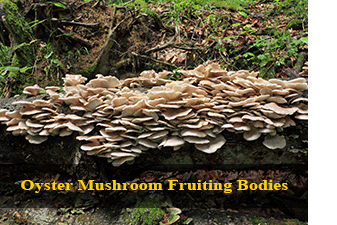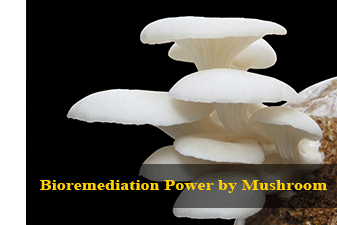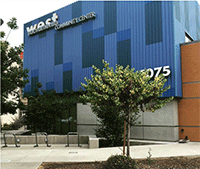The Power to Heal the World: Reclaiming Soils with Mushrooms
Author: Chad Kennedy, Landscape Architect, ASLA
 The mere presence of mushrooms on a piece of pizza, or on top of a burger, wields an incredible power to turn some children's heads in the opposite direction followed thereafter by a display of complete disgust, perhaps even convulsions and gagging. Though mushrooms seem to wield this irrational, but intriguing power, in recent years, mushrooms have been turning heads for a very different and fascinating reason: their natural power to heal the earth. Modern and historic land development practices and other human endeavors leave their mark on the environment. Unfortunately, some of that land is left behind and forgotten in a contaminated and polluted state. Often the level of pollution is so high that use of the land is prohibited unless measures are taken to repair, replace or heal it. Luckily, nature has provided, in the form of mushrooms (fungi), a way to clean-up polluted sites at a fairly rapid speed, with lower cost than if traditional methods were used.
The mere presence of mushrooms on a piece of pizza, or on top of a burger, wields an incredible power to turn some children's heads in the opposite direction followed thereafter by a display of complete disgust, perhaps even convulsions and gagging. Though mushrooms seem to wield this irrational, but intriguing power, in recent years, mushrooms have been turning heads for a very different and fascinating reason: their natural power to heal the earth. Modern and historic land development practices and other human endeavors leave their mark on the environment. Unfortunately, some of that land is left behind and forgotten in a contaminated and polluted state. Often the level of pollution is so high that use of the land is prohibited unless measures are taken to repair, replace or heal it. Luckily, nature has provided, in the form of mushrooms (fungi), a way to clean-up polluted sites at a fairly rapid speed, with lower cost than if traditional methods were used.
Need for Remediation
There is no denying that the human race has significant influence (for good and bad) on the health and viability of the world we inhabit. Unavoidable is the fact that we must deal with the impacts we have on the world by attempting to mitigate the negative ones. With a constant onslaught of stormwater pollutants, bio-waste disposal, and solid waste accumulation, there is a lot of work to be done. In fact, electronic waste, commonly referred to as e-waste, continues to grow at rates as high as 3-5% annually. This number is much higher than other solid waste and is concerning because of the high levels of contaminates contained within them. E-waste contains more than 1,000 substances that are of health or environmental concern.5 These and other substances such as heavy metals, pesticides, petroleum, excessive nutrients, and fecal coliform bacteria make their way into soils, creating dead zones of land that have little positive value and myriad negative implications.
Mushrooms & Fungi
Mushrooms are a diverse gateway species that can colonize in areas where other organisms cannot. They don't need light, many thrive in acidic soils, are found in every region of the world, they can degrade rock and metal, and can create massive organic networks. Fungi are not just the tabletop culinary gems that so many of us love, they have complex systems and metabolic functions. There are actually an estimated 1.5 million species of fungi of which we have only discovered 72,000.2 In fact, mycorrhiza fungi are engaged in a symbiotic relationship with approximately 80% of all plant species, helping to transform minerals and nutrients and aiding in plant growth.1 Also of interest is the fact that the largest living organism on earth is a 2,200 acre one cell thick fungi mat located in Oregon.7 These amazing fungi are all around us, secretly hiding societal benefits within them. They offer unlimited positive benefits that encompass health and nutrition, pest control, medicine, organic decomposition, and even soil remediation.
The Powers of Bioremediation 
There are several categories of bioremediation that involve fungi. Three of these are biodegradation, bisorption, and bioconversion. Each of these methods of bioremediation are important for reclaiming polluted land. In general, the process involves the introduction of a fungi species into contaminated soils followed by management for growth. Results can be seen within only weeks or months, but depending on type and levels of contaminants, may take longer to achieve desired outcomes.1,4
Biodegradation is the degradation, or recycling, of a complex substance into its basic mineral components. Fungi has an amazing ability to breakdown pollutants into their harmless (and even beneficial) components. However, pairing the right fungi with the target pollutant is of importance, as not all fungi are alike. This being the case, fungi have been shown in studies to degrade some of the most egregious pollutants such as plastics, herbicides, radioactive waste, crude oil, and Polycyclic aromatic hydrocarbons (PAH), returning soils to vibrant, biologically active conditions.4
Biosorption is the uptake of metals and pollutants from the environment into the mushroom tissue. This can happen through metabolic and non-metabolic processes and by living or non-living tissue. Fungi have been shown to be highly effective at biosorption of metals such as cadmium, copper, chromium zinc, lead, nickel, silver, and others.1,4 This use of fungi can be much more flexible and cost-effective than other traditional methods of reclamation. Many soils have been cleansed utilizing bisorption as a primary method of bioremediation.
Bioconversion is the transformation of industrial or agricultural waste and sludges into other more useful forms. In general, any product containing lignin (plant matter) can be used to grow mushrooms and is ultimately broken down. Examples of some of these waste products include cardboard industrial waste, sawdust, waste pulp, peels and husks, straw, etc.4 The result is an organic material that can be used to improve soil fertility and quality.
Other Practical Uses
Due to affordability, environmental soundness, low maintenance requirements, and the availability of fungi, there are many possible ways to capitalize on fungi's bioremediation properties. Studies have been performed that show incredible benefits (up to 3 times better than standard BMP's) for removal of fecal coliform bacteria and high nutrients from surface waters, showing great potential for surface water treatment options.8 Erosion control waddles and bags are now being inoculated with fungi to clean stormwater, graywater, and agricultural runoff in order to clean water before discharging off-site; oil spills on water bodies are being cleaned using floating "Mycobooms"; and fungi fields are being strategically planted to protect sensitive habitats and help regenerate forest flora.6
Though a great deal of research is needed to unlock all the secrets of fungi, what has been discovered thus far has enormous potential for protecting and repairing our world. Who would have thought, locked up in the inconspicuous mushroom lies the power to heal the world? To learn more about related issues and other landscape architecture topics, please visit the publications section of our website by clicking here.
1-Gadd, Geoffrey M. Mycotransformation of organic and inorganic substrates. Cambridge University Press. Mycologist, Volume 18, Part 2 May 2004.
2- Hawksworth , David L. and Amy Y. Rossman. Where Are All the Undescribed Fungi?. Phytopathology. The American Phytopathological Society. Vol. 87, No. 9, 1997. p 888-891
3-Jaitly. Ajai Kumar and Archana. Role of myco-communities in the field of heavy metal remediation. Biolife Journal. 3(1):77-108. 2016.
4-Kulshreshtha, Shweta. Nupur Mathur and Pradeep Bhatnagar. Mushroom as a product and their role in mycoremediation. AMB Express. 4:29. 2014
5-Ramasamy, Rajesh kumar. Shankar Congeevaram and Kaliannan Thamaraiselvi. Mycoremediation: Evaluation of Isolated Fungal Strain from e-waste Recycling Facility for Effective Sorption of Toxic Heavy Metal Pb (II) Ions and Fungal Protein Molecular Characterization- a Mycoremediation Approach. AJEB. VOL 2(2) 2011: 342-347
6-Stern, Nicole. Mycoremediation: Your Landscape On Mushrooms. The Field, ASLA Professional Practice Networks Blog. https://thefield.asla.org/category/ecology-and-restoration/. Posted 06-07-16. Accessed 06-30-16.
7-Stamets, Paul. "6 Ways Mushrooms Can Save the World." TED Talk, March 2008.
8-Thomas et. al. Field Demonstration of Mycoremediation for Removal of Fecal Coliform Bacteria and Nutrients in the Dungeness Watershed. U.S. Dept. of Energy. PNWD-4054-1. 2009.
 The mere presence of mushrooms on a piece of pizza, or on top of a burger, wields an incredible power to turn some children's heads in the opposite direction followed thereafter by a display of complete disgust, perhaps even convulsions and gagging. Though mushrooms seem to wield this irrational, but intriguing power, in recent years, mushrooms have been turning heads for a very different and fascinating reason: their natural power to heal the earth. Modern and historic land development practices and other human endeavors leave their mark on the environment. Unfortunately, some of that land is left behind and forgotten in a contaminated and polluted state. Often the level of pollution is so high that use of the land is prohibited unless measures are taken to repair, replace or heal it. Luckily, nature has provided, in the form of mushrooms (fungi), a way to clean-up polluted sites at a fairly rapid speed, with lower cost than if traditional methods were used.
The mere presence of mushrooms on a piece of pizza, or on top of a burger, wields an incredible power to turn some children's heads in the opposite direction followed thereafter by a display of complete disgust, perhaps even convulsions and gagging. Though mushrooms seem to wield this irrational, but intriguing power, in recent years, mushrooms have been turning heads for a very different and fascinating reason: their natural power to heal the earth. Modern and historic land development practices and other human endeavors leave their mark on the environment. Unfortunately, some of that land is left behind and forgotten in a contaminated and polluted state. Often the level of pollution is so high that use of the land is prohibited unless measures are taken to repair, replace or heal it. Luckily, nature has provided, in the form of mushrooms (fungi), a way to clean-up polluted sites at a fairly rapid speed, with lower cost than if traditional methods were used. 


